AMD's Radeon HD 6990: The New Single Card King
by Ryan Smith on March 8, 2011 12:01 AM EST- Posted in
- AMD
- Radeon HD 6990
- GPUs
Crysis: Warhead
Kicking things off as always is Crysis: Warhead, still one of the toughest game in our benchmark suite. Even 3 years since the release of the original Crysis, “but can it run Crysis?” is still an important question, and for 3 years the answer was “no.” However as we’ll see the 6990 changes that: full Enthusiast settings at a playable framerate is finally in the grasp of a single card.
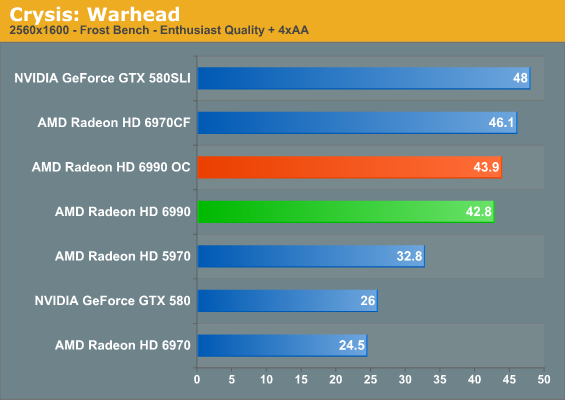
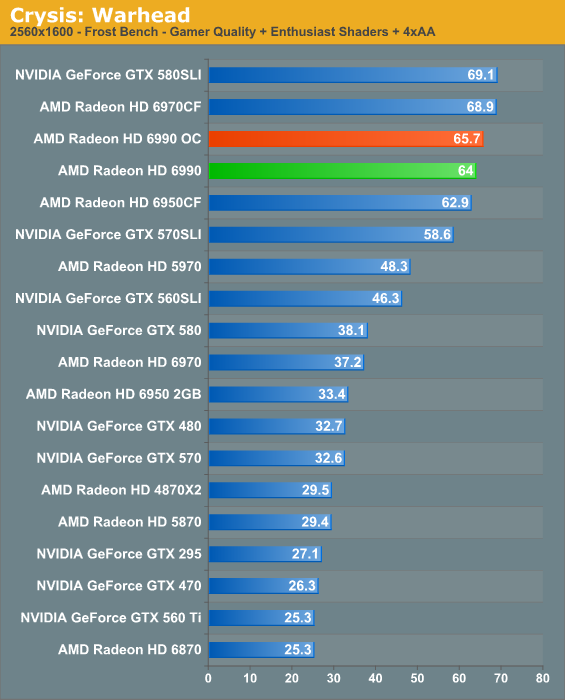
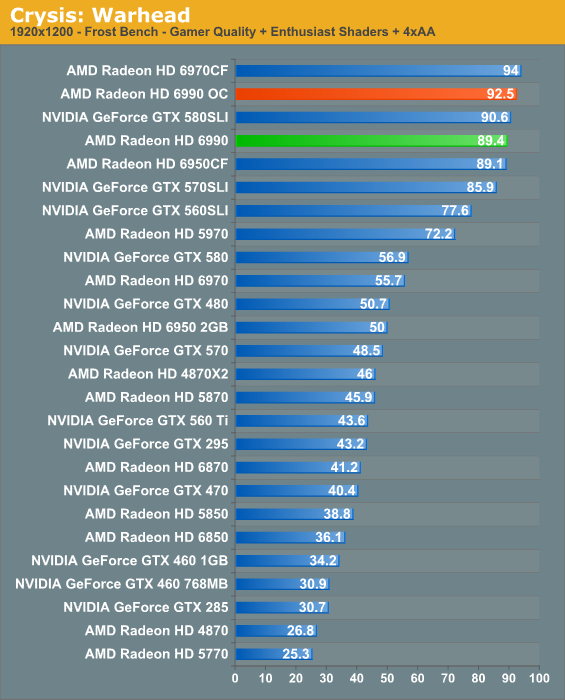
It should come as no surprise that with the 6990, AMD has hit a few different important marks on Crysis for a single card thanks to the card’s near-6970CF performance. As far as our traditional 2560 benchmark goes, the 6990 cracks 60fps, meaning we can finally play Crysis at a perfectly smooth framerate at 2560 with our tweaked settings on what is more or less a single video card. Perhaps more importantly however, performance is to the point where Crysis in full enthusiast mode is now a practical benchmark. Thanks in big part to the extra VRAM here, the tops the 5970 by nearly 30%, coming in at 42.8fps. This is still a bit low for a completely smooth framerate, but it is in fact playable, which is more than we can say for the 5970.
Overall Crysis does a good job setting the stage here for most of our benchmark suite: the performance of the card is consistently between the 6950CF and 6970CF, hovering much closer to the former. Compared to NVIDIA’s offerings the 6990 is solidly between the GTX 580 and GTX 580SLI, owing to the fact that NVIDIA doesn’t have a comparable card. The GTX 580SLI is faster, but the 580 is also still the fastest single-GPU card on the market, meaning it commands a significant price premium.
Overclocked to uber mode however only shows minimal gains, as the theoretical maximum gain is only 6% while the real world benefit is less; uber mode alone will never have a big payoff.

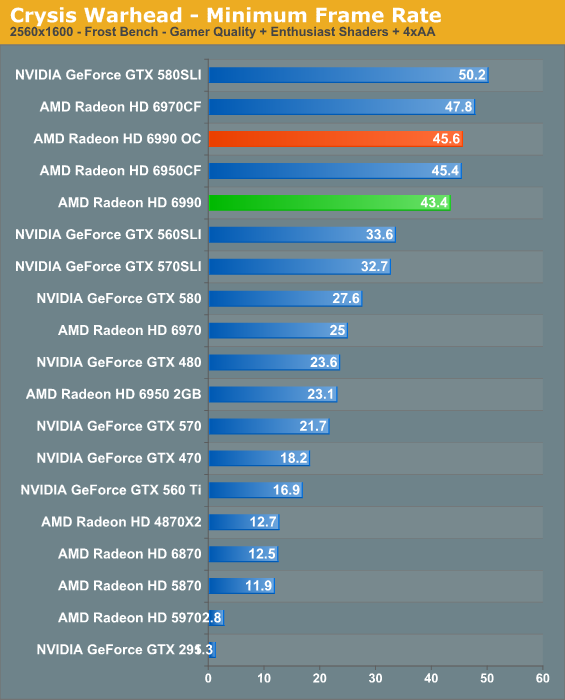
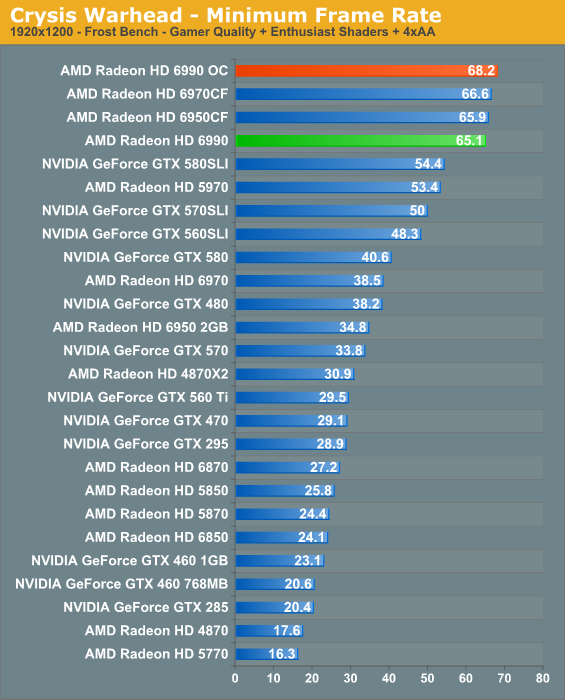
As far as minimum framerates are concerned the story is similar. For some reason the 6990 underperforms the 6950CF here by a frame or two per second, which given the 6990’s mostly superior specs leads us to believe that it’s a limitation of PCIe bus bandwidth. Meanwhile we can clearly see the benefits of more than 1GB of VRAM per GPU here: the 6990 walks all over the 5970.










130 Comments
View All Comments
nafhan - Tuesday, March 8, 2011 - link
I generally buy cards in the $100-$200 range. Power usage has gone up a bit while performance has increased exponentially over the last 10 years.LtGoonRush - Tuesday, March 8, 2011 - link
I'm disappointed at the choices AMD made with the cooler. The noise levels are truly intolerable, it seems like it would have made more sense to go with a triple-slot card that would be more capable of handling the heat without painful levels of noise. It'll be interesting to see how the aftermarket cooler vendors like Arctic Cooling and Thermalright handle this.Ryan Smith - Tuesday, March 8, 2011 - link
There's actually a good reason for that. I don't believe I mentioned this in the article, but AMD is STRONGLY suggesting not to put a card next to the 6990. It moves so much air that another card blocking its airflow would run the significant risk of killing it.What does this have to do with triple-slot coolers? By leaving a space open, it's already taking up 3 spaces. If the cooler itself takes up 3 spaces, those 3 spaces + 1 open space is now 4 spaces. You'd be hard pressed to find a suitable ATX board and case that could house a pair of these cards in Crossfire if you needed 8 open spaces. Triple slot coolers are effectively the kryptonite for SLI/CF, which is why NVIDIA isn't in favor of them either (but that's a story for another time).
arkcom - Tuesday, March 8, 2011 - link
2.5 slot cooler. That would guarantee at least half a slot is left for airspace.Quidam67 - Tuesday, March 8, 2011 - link
if it means a quieter card then that might have been a compromise worth making. Also, 2.5 would stop people from making the il-advised choice of using the slot next to the card, thus possibly killing it!strikeback03 - Tuesday, March 8, 2011 - link
With the height of a triple slot card maybe they could mount the fan on an angle to prevent blocking it off.kilkennycat - Tuesday, March 8, 2011 - link
Triple-slot coolers... no need!!However, if one is even contemplating Crossfire or SLI then a triple-slot space between the PCIe X16 SOCKETS for a pair of high-power 2-slot-cooler graphics cards with "open-fan" cooling (like the 6990) is recommended to avoid one card being fried by lack of air. This socket-spacing allows a one-slot clear air-space for the "rear" card's intake fan to "breathe". (Obviously, one must not plug any other card into any motherboard socket present in this slot)
In the case of a pair of 6990 (or a pair of nVidia's upcoming dual-GPU card), a minimum one-slot air-space between cards becomes MANDATORY, unless custom water or cryo cooling is installed.
Very few current Crossfire/SLI-compatible motherboards have triple-slot (or more) spaces between the two PCIe X16 connectors while simultaneously also having genuine X16 data-paths to both connectors. That socket spacing is becoming more common with high-end Sandy-Bridge motherboards, but functionality may still may be constrained by X8 PCIe data-paths at the primary pair of X16 connectors.
To even attempt to satisfy the data demands of a pair of 6990 Cross-Fire with a SINGLE physical CPU, you really do need a X58 motherboard and a Gulftown Corei7 990x processor, or maybe a Corei7 970 heavily overclocked. For X58 motherboards with triple-spaced PCIe sockets properly suitable for Crossfire or SLI , you need to look at the Asrock X58 "Extreme" series of motherboards. These do indeed allow full X16 data-paths to the two primary PCIe X16 "triple-spaced" sockets.
Many ATX motherboards have a third "so-called" PCIe X16 socket in the "slot7" position. However, this slot is always incapable of a genuine X16 pairing with either of the other two "X16" sockets, Anyway this "slot 7" location will not allow any more than a two-slot wide card when the motherboard is installed in a PC "tower" -- an open-fan graphics card will have no proper ventilation here, as it comes right up against either the power-supply (if bottom-loaded) or the bottom-plate of the case.
Spazweasel - Tuesday, March 8, 2011 - link
Exactly. For people who are going to do quad-Crossfire with these, you pretty much have to add the cost of a liquid cooling system to the price of the cards, and it's going to have to be a pretty studly liquid cooler too. Of course, the kind of person who "needs" (funny, using that word!) two of these is also probably the kind of person who would do the work to implement a liquid cooling system, so that may be less of an issue than it otherwise might be.So, here's the question (more rhetorical than anything else). For a given ultra-high-end gaming goal, say, Crysis @ max settings, 60fps @ 3x 2500x1600 monitors (something that would require quad Crossfire 69xx or 3-way SLI 580), with a targeted max temperature and noise level... which is the cheaper solution by the time you take into account cooling, case, high-end motherboard, the cards themselves? That's the cost-comparison that needs to be made, not just the cost of the cards themselves.
tzhu07 - Tuesday, March 8, 2011 - link
Before anyone thinks of buying this card stock, you should really go out and get a sense of what that kind of noise level is like. Unless you have a pair of high quality expensive noise-cancelling earbuds and you're playing games at a loud volume, you're going to constantly hear the fan.$700 isn't the real price. Add on some aftermarket cooling and that's how much you're going to spend.
Don't wake the neighbors...
Spivonious - Tuesday, March 8, 2011 - link
70dB is the maximum volume before risk of hearing loss, according to the EPA. http://www.epa.gov/history/topics/noise/01.htmSeriously, AMD, it's time to look at getting more performance per Watt.